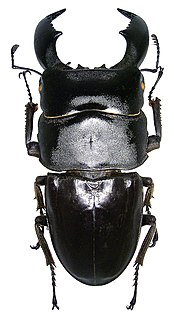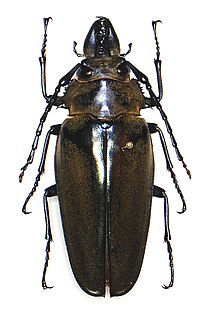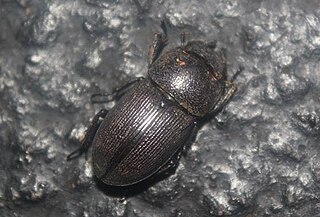
Stag beetles is a family of about 1,200 species of beetles in the family Lucanidae, currently classified in four subfamilies. Some species grow to over 12 centimetres, but most to about 5 cm (2 in).

The gold dust day gecko is a diurnal species of gecko. It lives in northern Madagascar, and on the island of Comoros; it has also been introduced to Hawaii and other Pacific islands. It's typically seen in houses and various trees. The gold dust day gecko feeds on insects and nectar. It is commonly known as the mascot of GEICO.

The fire-bellied toads are a group of six species of small frogs belonging to the genus Bombina.

The Chilean rose tarantula, also known as the rose hair tarantula, the Chilean fire tarantula, or the Chilean red-haired tarantula, is probably the most common species of tarantula available in American and European pet stores today, due to the large number of wild-caught specimens exported cheaply from their native Chile into the pet trade. The species is also known from Bolivia and Argentina.

The blue poison dart frog or blue poison arrow frog is a poison dart frog found in the forests surrounded by the Sipaliwini Savanna, which is located in southern Suriname and adjacent far northern Brazil. D. tinctorius azureus is also known by its indigenous Tirio name, okopipi. Its scientific name comes from its azure (blue) color. While frequently considered a valid species in the past, recent authorities treat it as a variant of D. tinctorius.

The winter white dwarf hamster, also known as the Russian dwarf hamster, Djungarian hamster, striped dwarf hamster, Siberian hamster, or Siberian dwarf hamster, is one of three species of hamster in the genus Phodopus. It is ball-shaped and typically half the size of the Syrian hamster, so is called a dwarf hamster along with all Phodopus species. Features of the winter white hamster include a typically thick, dark grey dorsal stripe and furry feet. As winter approaches and the days shorten, the winter white dwarf hamster's dark fur is almost entirely replaced with white fur. In captivity, this does not usually happen as animals maintained as pets are generally housed indoors and exposed to artificial light that prevents the recognition of short winter daylengths. In the wild, they originate from the wheat fields of Kazakhstan, the meadows of Mongolia and Siberia, and the birch stands of Manchuria.

Dorcus is a genus of beetles in the family Lucanidae. Of the 30-odd species, most occur in Asia and India; two are found in southern Europe, and two species are from North America. Previously, specimens with serriform teeth on the mandibles and sable pigment were called Serrognathus whereas specimens with but a singular or multiple bulky notches on the mandibles and lustrous sable pigmentation were called Dorcus. Serrognathus was recently reclassified and merged into the genus Dorcus.

Goliathus orientalis is a species of beetles belonging to the family Scarabaeidae.

Dorcus curvidens is a species of stag beetle. Its shell is flatter and duller than other related species.

Dorcus titanus is a beetle of the family Lucanidae. It was described by Jean Baptiste Boisduval in 1835. Huang and Chen (2013) separated Serognathus from Dorcus by representing morphological characters and DNA analysis.

Dorcus parallelipipedus, the lesser stag beetle, is a species of stag beetle found in Europe.

The Pacific parrotlet, also known as Lesson's parrotlet or the celestial parrotlet, is a species of small parrot in the family Psittacidae.

Polposipus herculeanus, the Frégate Island giant tenebrionid beetle or Frégate beetle, is a flightless species of beetle in family Tenebrionidae.

The sun parakeet, also known in aviculture as the sun conure, is a medium-sized, vibrantly colored parrot native to northeastern South America. The adult male and female are similar in appearance, with predominantly golden-yellow plumage and orange-flushed underparts and face. Sun parakeets are very social birds, typically living in flocks. They form monogamous pairs for reproduction, and nest in palm cavities in the tropics. Sun parakeets mainly feed on fruits, flowers, berries, blossoms, seeds, nuts, and insects. Conures are commonly bred and kept in aviculture and may live up to 30 years. This species is currently threatened by loss of habitat and trapping for plumage or the pet trade. Sun parakeets are now listed as endangered by the IUCN.
The Lucanidae are a family of beetles that include the stag beetles. The family can be further subdivided in a taxonomy. The classification presented here follows Smith (2006), with the exception of the tribal classification within the Lucaninae.

The Trictenotomidae are a small family of beetles in the suborder Polyphaga containing fifteen species in two genera. Most species are found in the Oriental realm where they live in montane forest habitats. The family is considered, based on larval characters as well as sequence-based studies, to be closely related to the Salpingidae.

Dorcus brevis is a species of stag beetle that can be found in the Eastern United States.

Dorcus rectus, the little stag beetle, is a species of beetles in the family Lucanidae. It is found in Japan. These beetles have a distinctive red shell that separates them from Dorcus curvidens.
Glenea pseudoscalaris is a species of beetle in the family Cerambycidae. It was described by Léon Fairmaire in 1895. It is known from Vietnam, China and Taiwan.
Lucanus datunensis is a species of stag beetle endemic to the Tatun Mountain of Taiwan’s Yangmingshan.It is first discovered in 1984. It is the smallest stag beetle in Taiwan and is an endangered species threatened by recent human activity.

















